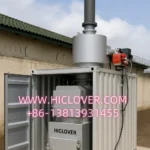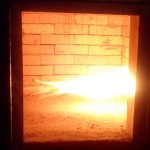Doubel Combustion Chamber
All Incinerators are Doubel Combustion Chamber with One Fuel Burner Each. After Burner Technology for Completely Combustion and Cleaner World.
Read MoreHigh Temperature Incineration
Temperature Range 800 Degree to 1200 Degree in Combustion Chamber. Temperature Thermocouple Monitor and Controller. High Quality Fire Brick and Refactory Cement.
Read MoreGet Lastest News
There are latest incinerator news like technical, public news, business tender for medical waste incinerator,animal incineration, pet cremation
Read MoreNanjing Clover Medical Technology Co.,Ltd.
Email: sales@clover-incinerator.com | Tel: +86-25-8461 0201
Regular model incinerator for market with burning rate from 10kgs to 500kgs per hour and we always proposal customer send us their require details, like waste material, local site fuel and power supply, incinerator operation time, etc, so we can proposal right model or custom made with different structure or dimensions.
Incinerator Model YD-100 is a middle scale incineration machine for many different usage: for a middle hospital sickbed below 500 units, for all small or big size family pets (like Alaskan Malamute Dog), for community Municipal Solid Waste Incineration, etc. The primary combustion chamber volume is 1200Liters (1.2m3) and use diesel oil or natural gas fuel burner original from Italy.
Latest Post
waste incinerator
Burring Ability 100/ 200 KG/ human resources Please develop your deal right here
Burner Kind Dual Chamber
Main Chamber
Gas to be taken advantage of Gas/ Deisel Please write your deal right here
Warmer Time 20 mins Please produce your deal listed below{
(adsbygoogle = window.adsbygoogle || []).push({});|}
(adsbygoogle = window.adsbygoogle || []).push({});
Kind of Paint Heat Resistance enamel paint compose your deal listed below.1. Ability: to cremate (carrion and also spoils) 350-400kg/ hr
4.
Type of Paint Warm Resistance enamel paint compose your offer below.1. Ability: to cremate (carrion and likewise spoils) 350-400kg/ hr
4. Heater weight: 1800-2000 kg
7.
6. Burner weight: 1800-2000 kg
7. Quantity: 0.70-0.80 m/cube
8. Outside measurement: 1.4-1.6 * 1.0-1.15 m (L * W)
Kenya Hospital Waste Incineration Solutions with HICLOVER
Kenya Hospital Waste Incineration Solutions with HICLOVER
Safe medical waste management is a critical challenge in East Africa, where hospitals and health centers generate increasing volumes of infectious and pathological waste. In Kenya, this issue is even more pressing, as the country serves not only its own healthcare facilities but also acts as a hub for international aid and donor-supported projects serving neighboring countries. The growing demand for a Kenya hospital sharps and pathological waste incinerator reflects the urgent need for durable, compliant, and mobile waste treatment solutions.
Hospital and WHO Health Center Requirements
Kenyan hospitals and WHO-supported health centers require incinerators that can handle a wide range of medical waste, including sharps containers, syringes, contaminated bandages, and pathological residues. A modern incinerator with automatic ignition for WHO health centers in Kenya ensures safe and reliable operation, even in resource-constrained environments.
The HICLOVER TS100 PLC model, for example, provides:
-
Automatic ignition with Riello burners for consistent and safe startup.
-
Dual-chamber combustion with a secondary chamber maintaining over 1100 °C and 2 seconds retention time.
-
PLC automatic control system with optional manual override for operator flexibility.
-
High alumina refractory lining (65% Al₂O₃) for long service life under continuous high-heat operation.
-
Optional wet scrubber and particulate filters to meet Kenya’s National Environment Management Authority (NEMA) emission standards.
These features ensure that county hospitals and WHO clinics in Kenya can operate equipment that minimizes fuel use, reduces emissions, and ensures full destruction of infectious material.
East Africa Regional Procurement Role
Kenya has established itself as a procurement hub for UN agencies, NGOs, and donor-funded projects that serve the wider region. Large-scale East Africa regional incinerator procurement through Kenya often supplies equipment for projects in Somalia, South Sudan, and Uganda. Nairobi acts as a central logistics and coordination center, ensuring that containerized mobile incinerators can be distributed rapidly to humanitarian camps, emergency field hospitals, and rural clinics.
By supplying containerized models in the 100–200 kg/hr range, HICLOVER supports both local healthcare facilities and regional relief operations. Containerized incinerators allow deployment without civil works, are shipped as standard ISO containers, and arrive ready to operate, making them ideal for regional distribution.
Containerized and Mobile Advantages
In Kenya, both permanent and temporary facilities benefit from containerized mobile incinerators. For hospitals in Nairobi or Kisumu, these units provide compliance with national emission rules and WHO guidelines. For UN and NGO field camps in Dadaab, Kakuma, or border regions, the same mobile incinerators provide essential waste disposal under humanitarian operations.
HICLOVER incinerators also feature:
-
Automatic cooling and restart systems for operational safety.
-
LCD progress displays for monitoring status and settings.
-
Optional dual fuel (diesel and natural gas) for flexibility in remote areas.
-
Mobility formats including containerized, trailer-mounted, or sledge-based designs for different terrains.
Conclusion
From a Kenya hospital sharps and pathological waste incinerator to an incinerator with automatic ignition for WHO health centers in Kenya, and even large-scale East Africa regional incinerator procurement through Kenya, HICLOVER provides versatile solutions for hospitals, clinics, and humanitarian operations. Models like the TS100 PLC offer the reliability, fuel efficiency, and compliance needed in Kenya’s healthcare landscape, while containerized mobile formats ensure rapid deployment across East Africa.
For project inquiries:
Website: www.hiclover.com
Email: sales@hiclover.com
Mobile (WhatsApp): +86-13813931455
Kenya Incinerator Solutions for Hospitals and Humanitarian Camps with HICLOVER
Kenya Incinerator Solutions for Hospitals and Humanitarian Camps with HICLOVER
The growing healthcare sector in Kenya has highlighted the urgent need for reliable medical waste management solutions. Hospitals and clinics across Nairobi, Mombasa, and county-level facilities must handle infectious sharps, contaminated gauze, pharmaceutical residues, and pathological waste safely and sustainably. In this context, the demand for a Kenya incinerator for hospital medical waste disposal has expanded rapidly, driven by both national regulations and donor-funded programs.
Hospital Applications with Refractory Lining
One of the key requirements for Kenyan hospitals is durability and safety under continuous high-temperature operation. Modern medical waste units from HICLOVER are built with high alumina refractory lining (65% Al₂O₃), designed to withstand up to 1750 °C. A well-constructed incinerator with refractory lining for Kenya hospitals ensures:
-
Long service life of the combustion chambers.
-
Consistent burn temperature in the range of 850–1200 °C.
-
Reduced fuel consumption thanks to high thermal retention.
-
Protection against thermal stress in high-throughput operations.
This is particularly vital for county referral hospitals, which generate large volumes of waste daily and require equipment that can operate reliably with minimal downtime.
HICLOVER TS150 PLC – A Reliable Model for Kenya
The HICLOVER TS150 PLC model, rated at 150 kg/hour, is an ideal fit for Kenya’s medium-to-large hospitals. It combines containerized mobility with advanced automation, including:
-
PLC automatic control system with optional manual override.
-
Dual combustion chambers, ensuring a minimum of 2 seconds retention time in the secondary chamber.
-
Automatic ignition with flame stabilization, reducing operator workload.
-
Corundum probe thermometers rated up to 1600 °C for accurate monitoring.
-
Optional wet scrubber to achieve compliance with NEMA and WHO emission standards.
Containerized construction allows the system to be installed without civil engineering works, making it suitable for both urban hospitals and rural county facilities.
Humanitarian Camps and Riello Burner Technology
Kenya hosts numerous UN agencies and NGO operations that support neighboring regions like Somalia and South Sudan. These humanitarian camps generate a diverse waste stream, from medical sharps to general solid waste, requiring robust disposal systems. The incinerator with Riello burner for humanitarian camps in Kenya provides dependable ignition, stable flame, and high combustion efficiency.
Riello G-series burners, widely used in HICLOVER systems, offer:
-
Low fuel consumption for diesel-fired operation.
-
Reliable ignition cycles, even in harsh field conditions.
-
Easy maintenance with available nozzle and electrode kits.
This technology ensures that humanitarian and peacekeeping camps can maintain environmental compliance while minimizing operational challenges.
Containerized and Mobile Advantages
For both hospitals and humanitarian projects, mobility is a decisive factor. HICLOVER’s containerized mobile incinerators are built into ISO containers or trailer-mounted designs, offering:
-
Rapid deployment in emergency response or refugee camp settings.
-
Weatherproof housing suitable for East African conditions.
-
Secure, fire-resistant construction with integrated chimneys.
-
Compatibility with dual-fuel operation (diesel and gas).
This mobility ensures that waste treatment capacity can be relocated as projects shift, a key requirement for NGOs and UN agencies operating across Kenya’s borders.
Conclusion
Kenya’s healthcare facilities and humanitarian operations demand high-quality incineration systems that combine durability, efficiency, and mobility. From a Kenya incinerator for hospital medical waste disposal to an incinerator with refractory lining for Kenya hospitals, and even an incinerator with Riello burner for humanitarian camps in Kenya, HICLOVER provides tailored solutions to match local needs. With models like the TS150 PLC and optional wet scrubber systems, HICLOVER supports Kenya’s commitment to safe, sustainable, and compliant waste management.
For inquiries:
Website: www.hiclover.com
Email: sales@hiclover.com
Mobile (WhatsApp): +86-13813931455
Medical incinerator rates
INCINERATOR WITH CONTROL UNIT
Has been specifically designed for use in:
– Hospitals
– Clinics
– Laboratories
– Disaster relief Operations
– Animal Cremation
– Can be used to Remove medical waste with reliable, on site
technology
An innovative system for medical facilities.
remove hospital waste (such as infectious and infectious waste)
efficiently, and with a minimum of expenses. Existing personnel can
be instructed on using this product.medical incinerator costs
The operator opens the primary chamber door, places the waste
indoors and turns on the unit. A timed cycle preset by the operator
begins and the waste is reduced to 5 percent ASH BY VOLUME.
– Designed by specialists in mobile systems.
– No onsite construction
– Minimal training for operators.
– Built for safe, easy operation with state-of-the-art controls.
– Dual chamber combustion and high exhaust temperatures, if
needed, in excess of 1025◦C.
– Preset cycle time automatically controls start up and shut down
– Thermostatic temperature control insures efficient fuel consumption.
Power requirement: 220 V, 0.35 KW/hr
Power requirement: 220 V, 0.35 KW/hr
incinerator manufacturers
– Manual technical monitoring is shipped with the hardware with all explanations of failures and resolutions
Controlled hygienic mechanical feeding that does not negatively influence the air temperature in the primary and secondary chambers of the incinerator shall be used.
N) The minimum exit velocity should be 10 metres per second and at least twice the surrounding wind speed (Efflux velocity = wind speed x 2) whichever is greater to make sure no down washing of exiting gases.
E) All the emission to the air apart from steam or water vapour has to be odourless and free of mist, fume and droplets.
Incinerator manufacturers To allow the Employer undertake conclusive evaluation of the tender, tenderers are asked to submit with their offers the detailed specifications, drawings and catalogues with commissioning and maintenance instructions for the Incinerator they intend to provide, install and commission. Tenderers who fail to comply with this requirement fully shall have their tenders rejected. 2. TECHNICAL SPECIFICATIONS OF THE REQUIRED INCINERATOR
2.1 General Description
The plant has to have four different sections that demonstrate three principles of turbulence, residence time and temperature retention. The controlled segments may include but not Limited to:
M ) The chimney should be visible to the operator from the feeding area.
3. Assessment and preparation and construction of a standard incinerator drop with one waste storage space ( see the layout )
4. Provision of operation and maintenance manuals and drawings complete with maintenance schedule and instructions.
5. Fuel oil storage tank- Moderate steel1500 liters capacity
6. Onsite training for operation and maintenance staff.
IMPORTANT
Supply, Installation and Commissioning of An Incinerator in Eastern Hydros [ Page 28
2.2 Feeding and Charging
F) A 99.99% destruction and removal efficiency (DRE) for each principal organic hazardous constituent (POHC) in the waste feed in which DRE [ ( Win – Wout) /Win ] x 100 where Win = mass feed rate of the POHC in the waste stream fed to incinerator and Wout = mass emission rate of POHC in the stack before the release to the atmosphere.
D) Opacity of the smoke shouldn’t exceed 20% seen from 50 metres with naked eyes.
1. SCOPE OF WORK The work specified in the contract will include.
2. Provision for adherence to OSHA and other statutory requirement relating to Health and Safety of employees during execution of the functions covered in this tender.
7. Minimum capacity of primary chamber = 0.18 cubic metres
2. Feed chamber/charging
c) Fabric filters
B ) An audible and visible alarm must be set up to warn the operator once the secondary chamber temperature drops to below the required temperature.
1. Supply, install and commission an incinerator as provided in the technical specifications
E) A solid particulate meter/recorder should be provided.
E) Make sure the emitted oxygen content of the emitted gases is less than 11 percent
B) The room should ensure a minimum exit temperature of 850 degrees centigrade.
2.4 Secondary Combustion Chamber (After burner)
a) ought to be fitted with burners that use low sulphur fuel.
B ) The temperature of the primary chamber shall be 800 +/- 50 degrees centigrade
4. Particulate scrubbers
O) The point for measurement of emissions shall be provided.
2.7 Instrumentation
a) Instrument for determining the inside wall temperature rather than burner flame temperature has to be given for both primary and secondary chambers.
2.3 Primary Combustion Chamber.
a) This room should be equipped with burners that use low sulphur fuel.
6. The stack/chimney.
C ) The secondary chamber gas residence time shall be at least 1 second at 1050 +/- 50 degrees centigrade with 3% oxygen in the stack gas.
5. Acid gas scrubbers.
C ) A carbon monoxide and oxygen meter/recorder should be provided
d) A smoke density meter/recorder should be provided.
2.5 Particulate Removers
A mechanical particulate collector has to be integrated after secondary combustion chamber for removal of particulate pollutants entrained in the flue gas stream. The particulate collectors may include any of the following or a combination thereof:
1. Overall plant layout
Capacity/island: 4000 kg/day; 25000 kg/day; 31000 kg/day; 48000 kg/day
Burning temperature — over 12000C
Two chambers — minimum
Emissions — dioxin and heavy metaly — better then Kyoto protocol
Emission — monitoring system
Waste unloiding — directly from squander track to incinerator
2.9 Emission Limits
a) Combustion efficiency (C.E) shall be at least 99.00% where C.E =%Carbon dioxide x 100 / [% Carbon dioxide + carbon monoxide]
C ) Ensure residence time isn’t less than two seconds.
2.6 Chimney/Stack
l) The chimney should have a minimum height of 10 metres above ground level and clear the maximum point of the building by not less than 3 metres for all roofs. The topography and height of adjacent buildings within 50 metres radius should be taken into account.
8. Burn rate (speed of waste incineration) = a least 20 kg per hour














